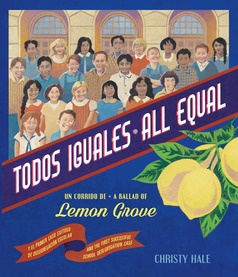 In this guest blog post, educator Cindy Jenson-Elliott of the Nativity Prep Academy describes how she used Todos iguales/All Equal as an inspiration for her classroom’s social justice comic book project.
In this guest blog post, educator Cindy Jenson-Elliott of the Nativity Prep Academy describes how she used Todos iguales/All Equal as an inspiration for her classroom’s social justice comic book project.
Engaging Students
As a teacher in San Diego’s only free private school for resource-challenged, first-generation college-bound students, I have the privilege of working at a school focused on social justice. Most of our students are English-language learners, and their parents have come to this country seeking a better life for their children. As a staff, we look for positive stories that teach about social change that comes through individual responsibility and action. The book Todos Iguales/All Equal: Un Corrido de Lemon Grove/A Ballad of Lemon Grove by Christy Hale, uses corridos, ballads of social justice, to tell the story of the Lemon Grove Incident. In Todos Iguales/All Equal, Mexican-American parents successfully challenged the Lemon Grove school district’s policy of segregating Mexican-American from white children in 1930. It is a powerful story not only because students’ families around our nation continue to face discrimination today, but because parents stood up for their children’s rights against a powerful system and won.
Explore
Lemon Grove, where the Incident took place, is only ten minutes from our school, and the school and public library still exist on the site. Students were immediately engaged in this important historical event by visiting the site, reading about the incident, and watching a historical film created by our public television station. We used this research to create a timeline of the incident. Then we divided the timeline into scenes, and each student chose a scene that they wanted to write and draw in order to tell the story.
Explain
In order to learn graphic storytelling techniques, students explored graphic nonfiction books as mentor texts. We read graphic nonfiction narratives such as March and Persepolis, and books such as Understanding Comics to examine the techniques authors and comic artists use to tell true stories. We invited comic artists Effren Villanueva and Alonso Nunez of Little Fish Comics to visit our school, and they taught lessons on how to write a script, and how to use perspective, camera angles, speech balloons, thought bubbles, and captions to tell a story.
Nunez stopped in front of each page and commented on what was effective, and what didn’t work as well in the scenes from the nonfiction graphic narrative they were creating. He noted students’ use of camera angles, and how they used speech balloons and captions to explain what was happening in each scene. As he followed the flow of civil rights story, students began to speak up, jumping in to offer additional information about the history they were recounting.
Now it was time for students to take their research into the Lemon Grove Incident, and their newfound understanding of narrative nonfiction comic techniques, and put it all together into an 8-panel scene for our comic book. They were required to create at least two drafts of their comic page or pages, with Nunez’s second classroom visit devoted to critiques.
Evaluate
When the narrative of the comic was done, each student took on an additional job in the comic publication process. Some acted as editors, making sure the narrative was correct historically, well-written editorially, and correctly drawn visually. One person drew the cover, and another drew the back. Students created dedication pages, an “about the author” page, and a table of contents. An Art Director and Editor in Chief worked together to evaluate the project as a whole and make sure the book was successful.
Exhibit
When students have an authentic audience for their writing, they understand that their voice matters, so to share our work with the public, we published our comic book. We also held a book signing at a comic book store, and each student sat at an author’s table to sign their books. In addition, we created a public exhibition of students’ framed comic art work in the Lemon Grove Public Library so that the public could learn about this important historical event.
Educate
The most striking thing about our exploration of the Lemon Grove Incident through Todos Iguales/All Equal is the similarities we noticed between the past and today’s climate. In the early 1930s, during the Great Depression, President Herbert Hoover ordered the deportation of nearly 500,000 Mexicans and Mexican-Americans — some of whom were American citizens. Creating our comic was a way for students to have a voice, to educate the public, and to right a historical wrong. I would love to see more teachers guide their students to research and write about local, historical civil rights and social justice issues through comics.
 About the author: Cindy Jenson-Elliott is an author and teacher. She teaches middle school science and writing at Nativity Prep Academy in San Diego, a free private school for college-bound, resource-challenged kids who will be the first in their families to go to college. She is the author of 17 nonfiction books for children, and has been an outdoor and garden educator for much of her life. You can find her on the web at www.cindyjensonelliott.com.
About the author: Cindy Jenson-Elliott is an author and teacher. She teaches middle school science and writing at Nativity Prep Academy in San Diego, a free private school for college-bound, resource-challenged kids who will be the first in their families to go to college. She is the author of 17 nonfiction books for children, and has been an outdoor and garden educator for much of her life. You can find her on the web at www.cindyjensonelliott.com.


